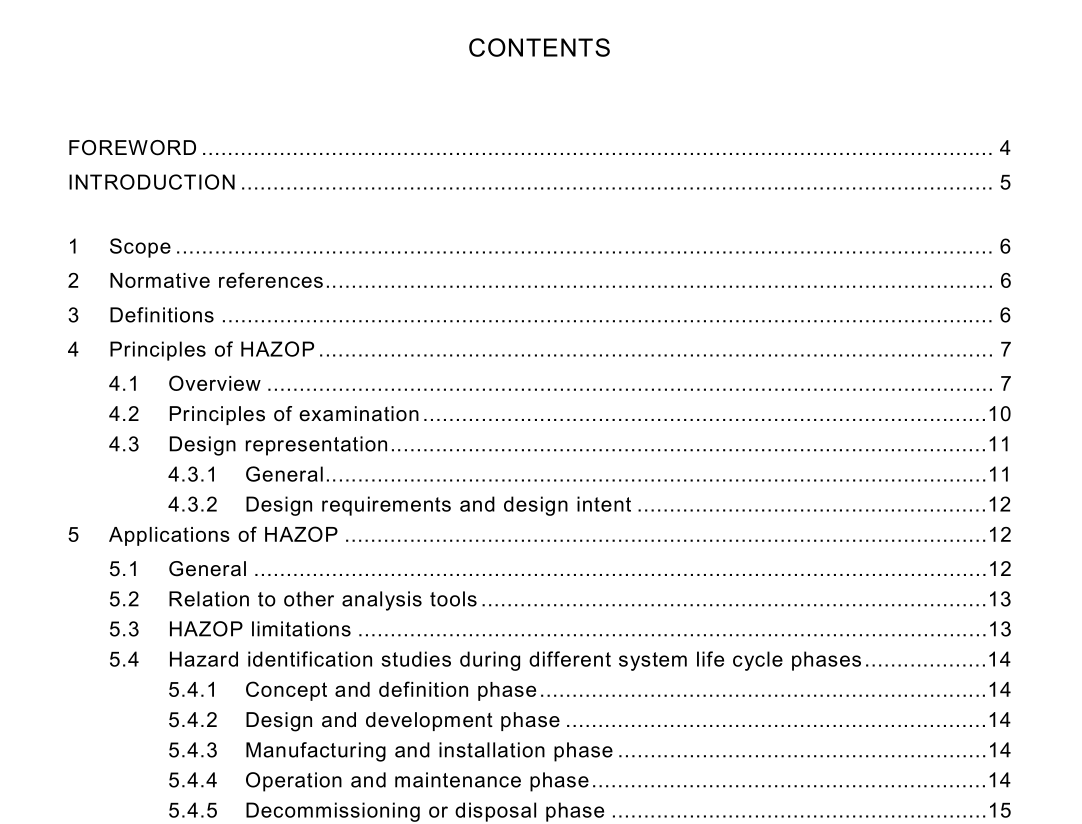BS IEC 61882 pdf download

BS IEC 61882 pdf download.Hazard and operability studies (HAZOP studies) — Application guide
1 Scope
This International Standard provides a guide for HAZOP studies of systems utilizing the specific set of guide words defined in this document. It also gives guidance on application of the technique and on the HAZOP study procedure, including definition, preparation, examination sessions and resulting documentation and follow-up. Documentation, as well as a broad set of examples encompassing various industries, illustrating HAZOP examination is also provided.
3 Definitions
For the purposes of this International Standard, definitions contained in IEC 60050(1 91 ) as well as the following terms and definitions apply: 3.1 characteristic qualitative or quantitative property of an element NOTE Examples of characteristics are pressure, temperature, voltage. 3.2 design intent designer’s desired, or specified range of behaviour for elements and characteristics3.3 deviation departure from the design intent 3.4 element constituent of a part which serves to identify the part’s essential features NOTE The choice of elements may depend upon the particular application, but elements can include features such as the material involved, the activity being carried out, the equipment employed, etc. Material should be considered in a general sense and includes data, software, etc. 3.5 guide word word or phrase which expresses and defines a specific type of deviation from an element’s design intent 3.6 harm physical injury or damage to the health of people or damage to property or the environment 3.7 hazard potential source of harm 3.8 part section of the system which is the subject of immediate study NOTE A part may be physical (e.g. hardware) or logical (e.g. step in an operational sequence). 3.9 risk combination of the probability of occurrence of harm and the severity of that harm
4 Principles of HAZOP
4.1 Overview A HAZOP study is a detailed hazard and operability problem identification process, carried out by a team. HAZOP deals with the identification of potential deviations from the design intent, examination of their possible causes and assessment of their consequences. Key features of HAZOP examination include the following. The examination is a creative process. The examination proceeds by systematically using a series of guide words to identify potential deviations from the design intent and employing these deviations as “triggering devices” to stimulate team members to envisage how the deviation might occur and what might be the consequences. The examination is carried out under the guidance of a trained and experienced study leader, who has to ensure comprehensive coverage of the system under study, using logical, analytical thinking. The study leader is preferably assisted by a recorder who records identified hazards and/or operational disturbances for further evaluation and resolution. The examination relies on specialists from various disciplines with appropriate skills and experience who display intuition and good judgement. The examination should be carried out in a climate of positive thinking and frank discussion. When a problem is identified, it is recorded for subsequent assessment and resolution. Solutions to identified problems are not a primary objective of the HAZOP examination, but if made they are recorded for consideration by those responsible for the design. HAZOP studies consist of four basic sequential steps, shown in Figure 1 .
4.2 Principles of examination
The basis of HAZOP is a “guide word examination” which is a deliberate search for deviations from the design intent. To facilitate the examination, a system is divided into parts in such a way that the design intent for each part can be adequately defined. The size of the part chosen is likely to depend on the complexity of the system and the severity of the hazard. In complex systems or those which present a high hazard the parts are likely to be small. In simple systems or those which present low hazards, the use of larger parts will expedite the study. The design intent for a given part of a system is expressed in terms of elements which convey the essential features of the part and which represent natural divisions of the part. The selection of elements to be examined is to some extent a subjective decision in that there may be several combinations which will achieve the required purpose and the choice may also depend upon the particular application. Elements may be discrete steps or stages in a procedure, individual signals and equipment items in a control system, equipment or components in a process or electronic system, etc.









